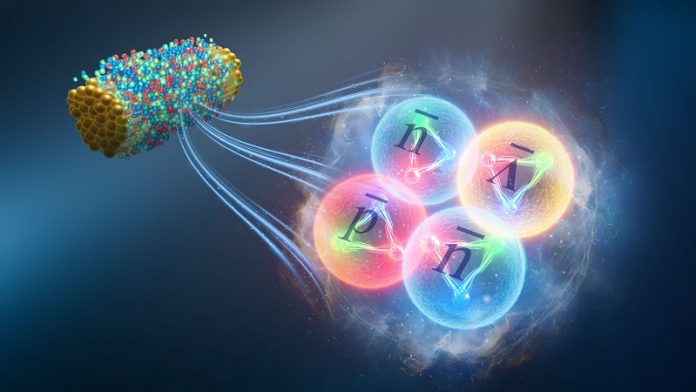
In an incredible breakthrough, scientists working at the Relativistic Heavy Ion Collider (RHIC), a powerful machine that smashes atomic nuclei together to recreate conditions similar to those just after the Big Bang, have discovered a new type of antimatter nucleus.
This is the heaviest antimatter nucleus ever found, and it’s made up of four antimatter particles: one antiproton, two antineutrons, and one antihyperon.
The scientists have named this exotic antimatter nucleus antihyperhydrogen-4.
This discovery was made by members of the STAR Collaboration, a team of researchers who use a gigantic particle detector to analyze the debris from billions of these nuclear collisions.
They’ve reported their findings in the journal Nature, and they’ve even used these unusual antiparticles to explore differences between matter and antimatter.
“Our understanding of physics tells us that, except for having opposite electric charges, antimatter should behave just like matter—same mass, same lifetime before decaying, and same interactions,” explained Junlin Wu, a STAR collaborator and graduate student at Lanzhou University and the Institute of Modern Physics in China.
But there’s a big mystery: while both matter and antimatter are believed to have been created in equal amounts at the time of the Big Bang, the universe today is made almost entirely of matter.
Where did all the antimatter go? This is one of the biggest unanswered questions in physics.
RHIC, a facility run by the U.S. Department of Energy at Brookhaven National Laboratory, is one of the best places in the world to study antimatter.
In this “atom smasher,” heavy ions—atomic nuclei stripped of their electrons—are accelerated to nearly the speed of light and then collided.
These collisions generate extreme amounts of energy, breaking down the protons and neutrons inside the nuclei into their most basic components: quarks and gluons. This forms a hot, dense “soup” that closely resembles the conditions of the early universe.
From this quark-gluon soup, thousands of new particles are born, and RHIC produces matter and antimatter in nearly equal amounts, just like the early universe.
By studying these particles, scientists hope to find clues that might explain why our universe is dominated by matter rather than antimatter.
To explore this matter-antimatter imbalance, scientists first need to discover new antimatter particles. According to Hao Qiu, a STAR physicist and Wu’s advisor at the Institute of Modern Physics, this is the basic idea behind their study.
STAR physicists have detected antimatter nuclei at RHIC before. In 2010, they observed the first antimatter nucleus containing a hyperon, which is a particle with at least one “strange” quark (unlike the lighter “up” and “down” quarks found in protons and neutrons).
A year later, they discovered antihelium-4, the antimatter counterpart of a helium nucleus, setting a record for the heaviest antimatter nucleus at the time.
More recently, researchers suspected that they might be able to detect an even heavier antimatter nucleus—antihyperhydrogen-4. This nucleus is unique because it contains an antihyperon called an antilambda particle in place of one of the protons in antihelium.
However, finding this unstable antihypernucleus is incredibly rare.
All four of its components—one antiproton, two antineutrons, and one antilambda—must be created in the quark-gluon soup at just the right time and place, traveling in the same direction, to combine into a temporarily stable nucleus.
“It’s really a matter of chance that these four particles emerge from the RHIC collisions close enough together to form this antihypernucleus,” said Lijuan Ruan, a Brookhaven Lab physicist and one of the co-spokespersons for the STAR Collaboration.
This discovery not only sets a new record but also brings us a step closer to understanding one of the greatest mysteries of the universe: why matter dominates over antimatter.



